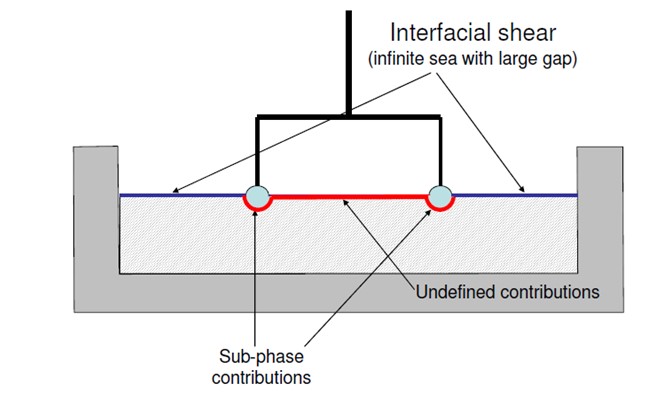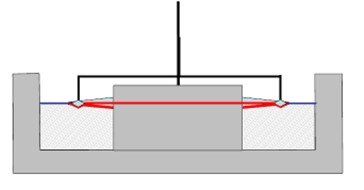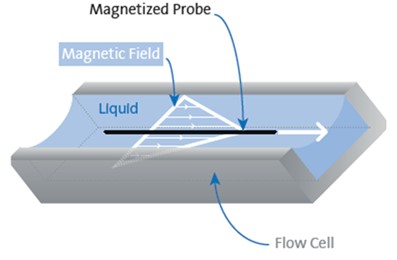
Interfacial rheology studies the response of the interfacial layer as it is deformed by external stimuli. Interfacial rheology measurements are typically divided into dilatation and shear methods. In dilatational methods, the area of the interface is changed and the response to the change is typically detected by measuring the surface tension or surface pressure change. In interfacial shear rheology, the area of the interface stays constant but instead the shape of the interface is deformed. In this blog post, the most common interfacial shear rheology methods are reviewed.
Bicone is a flat disk that is placed at the air-liquid or liquid-liquid interface as presented in the image.
![]() The plate is rotated at the interface and the viscoelastic properties can be calculated from the torque and displacement raw data. The precision of the data is determined by the instrument resolution and dimension geometry. Due to the large size of the probe, the subphase contribution to the results is large and the sensitivity of the method is quite poor. The positioning of the plate at the interface can be challenging, although the sharp edge of the probe does pin to it. It is also not possible to measure nor control the surface pressure during the measurement. Due to low sensitivity, the method is mainly suitable for rather stiff interfaces.
The plate is rotated at the interface and the viscoelastic properties can be calculated from the torque and displacement raw data. The precision of the data is determined by the instrument resolution and dimension geometry. Due to the large size of the probe, the subphase contribution to the results is large and the sensitivity of the method is quite poor. The positioning of the plate at the interface can be challenging, although the sharp edge of the probe does pin to it. It is also not possible to measure nor control the surface pressure during the measurement. Due to low sensitivity, the method is mainly suitable for rather stiff interfaces.
Du Noüy ring method was originally developed to measure the surface tension of a liquid or interfacial tension between two immiscible liquids. Du Noüy ring can be added as an accessory to the bulk rheometer similarly to the bicone to allow interfacial rheology measurements. Compared to the bicone method, the Du Noüy ring offers a light geometry with a small moment of inertia. There is, however, no full flow field analysis available for the Du Noüy ring which reduces its use to strong films only. The inner area of the ring is not considered which is problematic in cases where the film is formed both inside and outside of the ring. The ring can also be extremely difficult to place at the interface due to the round cross-section of the ring. For the same reason, the film can easily flow on top of the ring. As with bicone, there is no possibility to directly control or measure the surface pressure.
Du Noüy ring can be added as an accessory to the bulk rheometer similarly to the bicone to allow interfacial rheology measurements. Compared to the bicone method, the Du Noüy ring offers a light geometry with a small moment of inertia. There is, however, no full flow field analysis available for the Du Noüy ring which reduces its use to strong films only. The inner area of the ring is not considered which is problematic in cases where the film is formed both inside and outside of the ring. The ring can also be extremely difficult to place at the interface due to the round cross-section of the ring. For the same reason, the film can easily flow on top of the ring. As with bicone, there is no possibility to directly control or measure the surface pressure.
Double-wall ring (DWR) is the most advanced of the methods available as add-ons to bulk rheometers.  By having a double-wall structure on a measurement cell, it solves the issue of the undefined contribution of the inside of the ring related to the Du Noüy ring. Also, the cross-section of the ring is diamond-shaped which helps to pin the probe at the interface better than the Du Noüy ring. However, keeping the interface height constant requires the use of an external syringe pump. There is no direct way of controlling or measuring the surface pressure of the interface.
By having a double-wall structure on a measurement cell, it solves the issue of the undefined contribution of the inside of the ring related to the Du Noüy ring. Also, the cross-section of the ring is diamond-shaped which helps to pin the probe at the interface better than the Du Noüy ring. However, keeping the interface height constant requires the use of an external syringe pump. There is no direct way of controlling or measuring the surface pressure of the interface.
ISR Flip is an interfacial shear rheometer based on a mobile magnetic trap.  In ISR Flip, a floating magnetized needle oscillates at the air-liquid or liquid-liquid interface with the help of a mobile magnetic trap with permanent magnets. The movement of the probe is recorded with the high-resolution camera and the information is coupled with the trap movement to calculate the viscoelastic properties of the film. As the probe is floating at the interface, there are no positioning problems related to it and it will also stay trapped at the interface during long measurements. The light weight of the probe makes this the most sensitive interfacial shear rheometer on the market.
In ISR Flip, a floating magnetized needle oscillates at the air-liquid or liquid-liquid interface with the help of a mobile magnetic trap with permanent magnets. The movement of the probe is recorded with the high-resolution camera and the information is coupled with the trap movement to calculate the viscoelastic properties of the film. As the probe is floating at the interface, there are no positioning problems related to it and it will also stay trapped at the interface during long measurements. The light weight of the probe makes this the most sensitive interfacial shear rheometer on the market.
Combining a trough with the Wilhelmy balance enables monitoring and controlling the surface pressure throughout the interfacial rheology measurement. If you want to hear more about ISR with mobile magnetic trap, please register for the webinar through the link below.
Emulsions are dispersed systems of two immiscible liquids such as oil and water. Interfacial rheology measurements predict emulsion and foam stability.
The same measurement modes used in bulk rheology are also meaningful in interfacial rheology.
Pickering emulsions utilize solid particles to stabilize the interface between the two immiscible liquids
International Congress on Interfacial Rheology was held in Athens from the 29th of July to the 4th of August 2023.
Foam stability refers to the ability of a foam to maintain its structure and resist collapse over time.
Interfacial rheology studies the response of the interfacial layer to the external stimuli at air-liquid or liquid-liquid interfaces.
Interfacial shear rheology at the gas-liquid or liquid-liquid interface is relevant in a wide range of applications where foams and emulsions are used.
Interfacial rheology is a special branch of rheology that involves studying the unique two-dimensional systems formed at interfaces.
